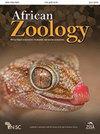血虫Arenicola loveni(环节动物门;Arenicolidae)的遗传结构表明,面对过度开发,局部灭绝的风险低于预期
IF 0.5
4区 生物学
Q4 ZOOLOGY
引用次数: 6
摘要
这种名为Arenicola loveni的血虫通常被渔民用作诱饵,由于其K选择的生活史策略和过度开发,可能很容易在当地灭绝。然而,可以为管理提供信息的准确种群数据已经过时,而对血虫的需求仍在继续,甚至正在增加。这项研究提供了在南非西开普省的七个地点和东开普省的一个地点采样的A.loveni种群结构的遗传数据。线粒体细胞色素氧化酶I(COI)数据表明,该种群形成了两个谱系,应分别管理:一个西方谱系主要包含来自萨尔达尼亚湾的样本,另一个南方谱系包含来自南海岸(Muizenberg至Swartkops)的样本。核内转录间隔区(ITS)和COI基因的单倍型较高,但核苷酸多样性较低,这表明这两个谱系的种群最近有共同的祖先。南海岸大多数种群的配对固定指数(Fst)值较低,并且各地区共享常见的单倍型,表明种群之间存在一定程度的连通性。然而,每个位点都存在许多私人单倍型,这表明当地种群也严重依赖区域招募。种群之间的基因流动,以及西部和南部谱系之间缺乏这种流动,很可能归因于主要海洋环流模式促进的幼虫传播。这些结果表明,尽管个体种群可以通过从其他地方招募来防止当地灭绝,但如果诱饵压力增加,对当地招募的依赖可能会使种群变得脆弱。本文章由计算机程序翻译,如有差异,请以英文原文为准。
Genetic Structure of Bloodworm, Arenicola loveni (Annelida; Arenicolidae) Suggests Risk of Local Extinction in the Face of Overexploitation is Lower Than Expected
The bloodworm, Arenicola loveni, is commonly used as bait by fishers and may be vulnerable to local extinction owing to its K-selected life history strategies and overexploitation. Accurate population data that can inform management is, however, outdated, whereas demand for bloodworm continues or is even increasing. This study provides genetic data on the population structure of A. loveni sampled at seven sites in the Western Cape and one in the Eastern Cape Provinces of South Africa. Mitochondrial cytochrome oxidase I (COI) data indicate that the population forms two lineages that should be managed separately: a western lineage that contains mostly samples from Saldanha Bay and a southern lineage that contains samples from the south coast (Muizenberg to Swartkops). High haplotypic, but low nucleotide diversity for the nuclear internal transcribed spacer (ITS) and COI genes, suggest that populations from both lineages have a recent common ancestry. Low pairwise Fixation index (Fst) values among most populations on the south coast, and common haplotypes shared among localities, indicate some degree of connectivity among populations. The presence of many private haplotypes at each site, however, indicates that local populations also rely heavily on regional recruitment. Gene flow among populations, and the absence of this between the western and southern lineages, is most likely attributed to larval dispersal facilitated by the predominant oceanic circulation patterns. These results suggest that although individual populations may be protected against local extinction through recruitment from elsewhere, reliance on local recruits may render populations vulnerable should baiting pressure increase.
求助全文
通过发布文献求助,成功后即可免费获取论文全文。
去求助
来源期刊

African Zoology
生物-动物学
CiteScore
2.60
自引率
9.10%
发文量
18
审稿时长
>12 weeks
期刊介绍:
African Zoology , a peer-reviewed research journal, publishes original scientific contributions and critical reviews that focus principally on African fauna in terrestrial, freshwater, and marine ecosystems. Research from other regions that advances practical and theoretical aspects of zoology will be considered. Rigorous question-driven research in all aspects of zoology will take precedence over descriptive research. The Journal publishes full-length papers, critical reviews, short communications, letters to the editors as well as book reviews. Contributions based on purely observational, descriptive or anecdotal data will not be considered.
The Journal is produced by NISC in association with the Zoological Society of South Africa (ZSSA). Acceptance of papers is the responsibility of the Editors-in-Chief in consultation with the Editors and members of the Editorial Advisory Board. All views expressed are those of the author and not necessarily those of the Editors or the Department.
 求助内容:
求助内容: 应助结果提醒方式:
应助结果提醒方式:


